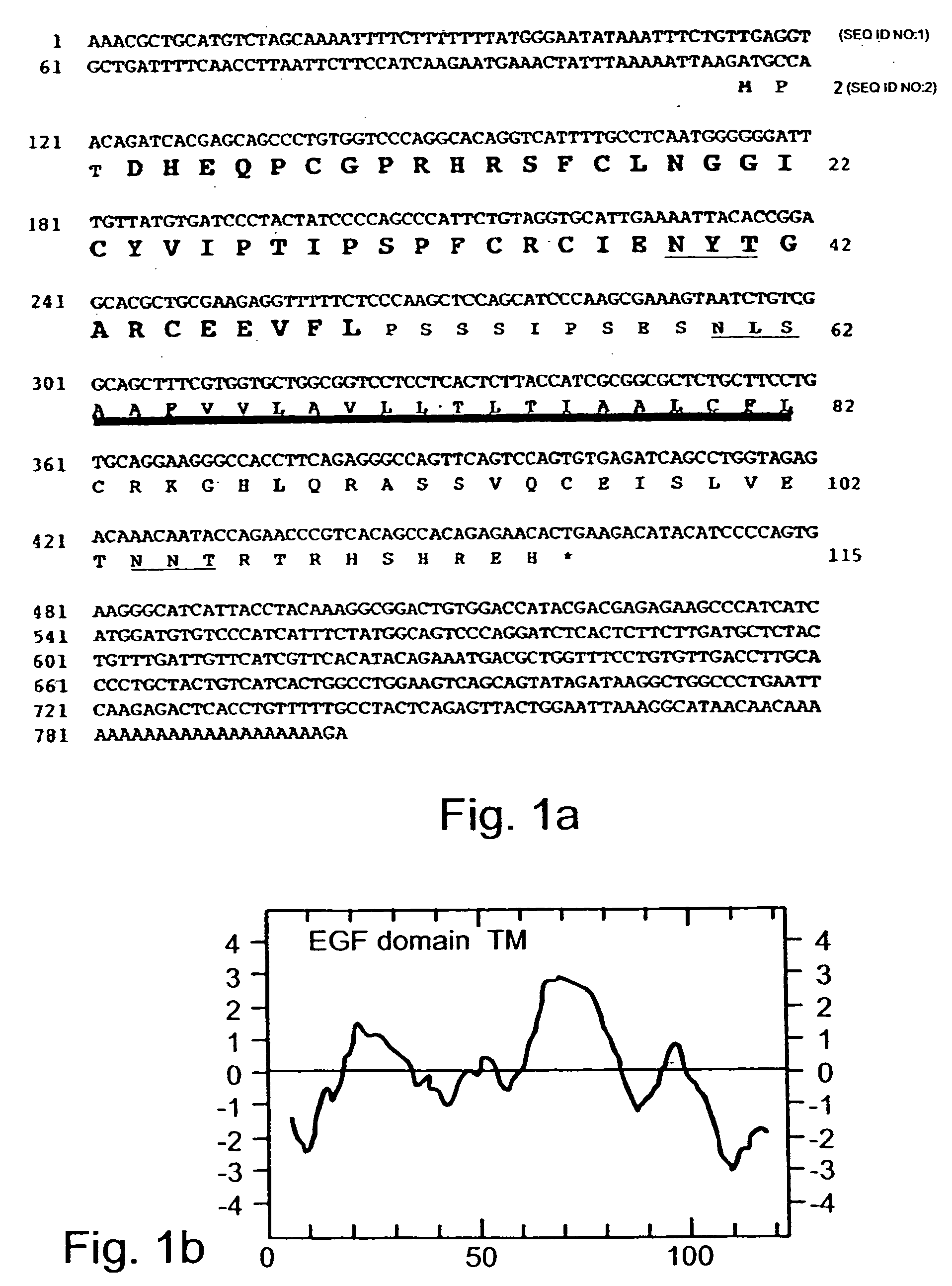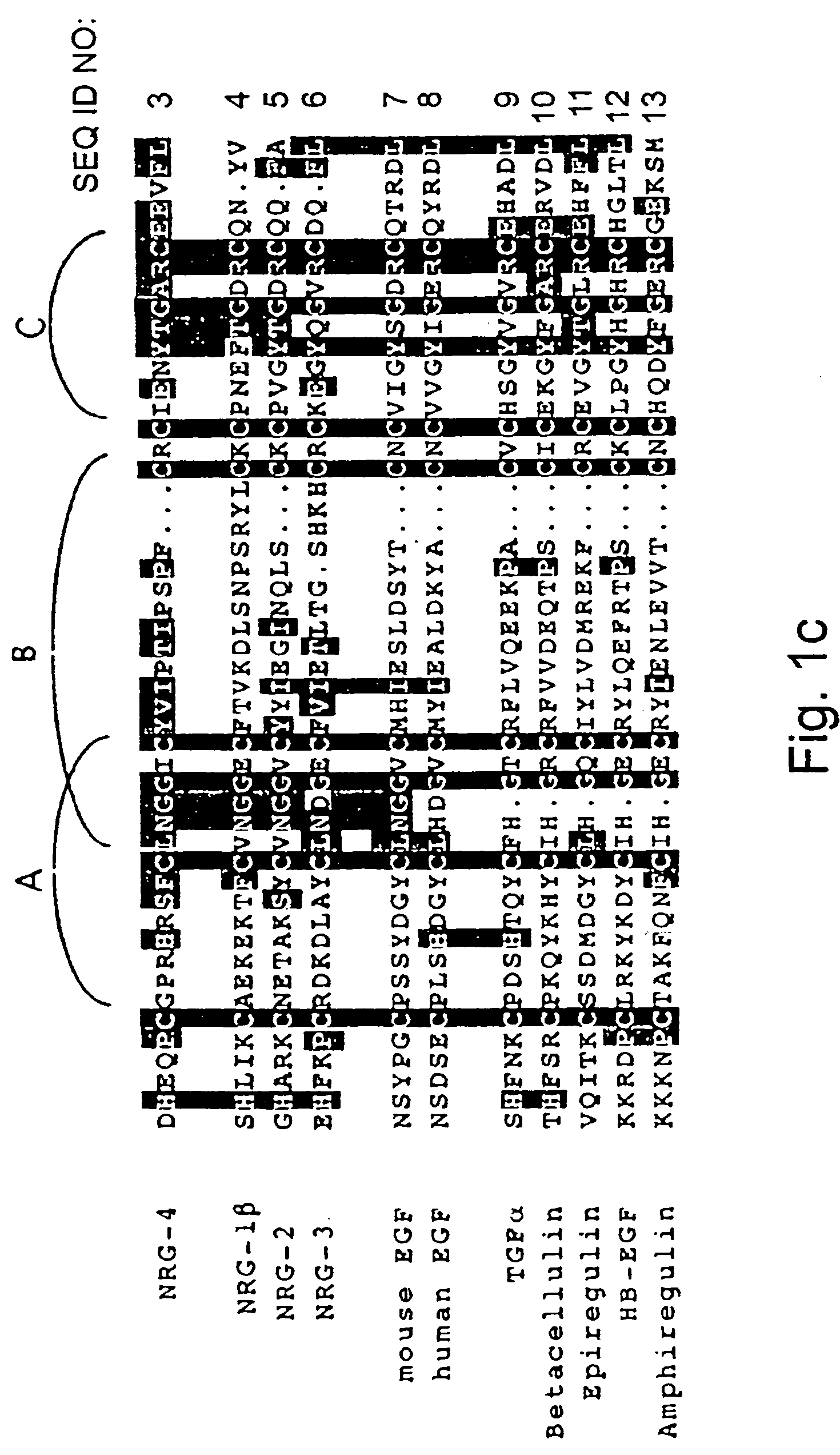However, the absence of a
characteristic sequence may not exclude the possibility that NRG-4 acts as a secreted
growth factor, because other
signal peptide-less growth factors can be secreted or released from producer cells through alternative secretory mechanisms or upon
cell lysis.
This finding may indicate that under some physiological conditions, the expression of ErbB-4 alone may be insufficient to elicit a biological response to NRG-4, requiring a co-
receptor such as ErbB-2 to transduce its
signal.
The result is that a large area becomes rapidly infected, most of which was not initially infected by the original viral particles.
Alternatively, such
hybrid formation may lead to interference with correct splicing.
Unmodified oligonucleotides are typically impractical for use as antisense sequences since they have short
in vivo half-lives, during which they are degraded rapidly by nucleases.
Furthermore, they are difficult to prepare in more than milligram quantities.
In addition, such oligonucleotides are poor
cell membrane penetraters.
Such molecules bind to the targeted
gene molecules in
RNA of
tumor cells, thereby inhibiting the translation of the genes and resulting in dysfunctional growth of these cells.
However, due to their low stability
RNA oligonucleotides are typically expressed inside the cells using vectors designed for this purpose.
In contrast, purification of IgG-3 requires the use of
immobilized protein G, a significantly less versatile medium.
This extremely limited binding profile can allow the delivery of drugs to a limited
repertoire of cells, allowing for smaller
drug doses to be used and limiting the chances of generic toxic side effects to take place in patients.
The use of LCR for
mutant screening is limited to the examination of specific
nucleic acid positions.
However, available thermostable
DNA ligases are not effective on this
RNA substrate, so the
ligation must be performed by T4
DNA ligase at low temperatures (37 degrees C.).
Therefore the reaction temperatures cannot be raised to prevent non-specific hybridization of the probes.
In practice, routine
polymerase chain reactions rarely achieve the theoretical maximum yield, and PCRs are usually run for more than 20 cycles to compensate for the
lower yield.
Reaction conditions must be carefully optimized for each different primer pair and target sequence, and the process can take days, even for an experienced investigator.
The laboriousness of this process, including numerous technical considerations and other factors, presents a significant drawback to using PCR in the clinical setting.
Indeed, PCR has yet to penetrate the clinical market in a significant way.
One method of the detection of
allele-specific variants by PCR is based upon the fact that it is difficult for
Taq polymerase to synthesize
a DNA strand when there is a mismatch between the template strand and the 3' end of the primer.
This method has a substantial limitation in that the base composition of the mismatch influences the ability to prevent extension across the mismatch, and certain mismatches do not prevent extension or have only a
minimal effect (Kwok et al., Nucl.
Any mismatch effectively blocks the action of the thermostable ligase, but LCR still has the drawback of target-independent background
ligation products initiating the amplification.
Moreover, the combination of PCR with subsequent LCR to identify the nucleotides at subject positions is also a clearly cumbersome proposition for the clinical laboratory.
Traditional methods of direct detection including Northern and Southern band RNase protection assays usually require the use of radioactivity and are not amenable to
automation.
While the repeating process increases the
signal, the RNA portion of the oligonucleotide is vulnerable to RNases that may carried through
sample preparation.
However, specialized equipment and highly trained personnel are required, and the method is too labor-intense and expensive to be practical and effective in the clinical setting.
However, this method requires the use of
osmium tetroxide and
piperidine, two highly noxious chemicals which are not suited for use in a clinical laboratory.
RFLP analysis suffers from low sensitivity and requires a large amount of sample.
When RFLP analysis is used for the detection of point mutations, it is, by its nature, limited to the detection of only those single base changes which fall within a restriction sequence of a known restriction
endonuclease.
Moreover, the majority of the available enzymes have 4 to 6 base-pair recognition sequences, and cleave too frequently for many large-scale
DNA manipulations (Eckstein and Lilley (eds.
Furthermore, the method requires specialized equipment to prepare the gels and maintain the needed high temperatures during
electrophoresis.
In addition, long running times are required for DGGE.
This technique is extremely sensitive to variations in gel composition and temperature.
A serious limitation of this method is the relative difficulty encountered in comparing data generated in different laboratories, under apparently similar conditions.
While ddF is an improvement over SSCP in terms of increased sensitivity, ddF requires the use of expensive dideoxynucleotides and this technique is still limited to the analysis of fragments of the size suitable for SSCP (i.e., fragments of 200-300 bases for optimal detection of mutations).
In addition to the above limitations, all of these methods are limited as to the size of the
nucleic acid fragment that can be analyzed.
For the
direct sequencing approach, sequences of greater than 600 base pairs require
cloning, with the consequent delays and expense of either deletion sub-
cloning or primer walking, in order to cover the entire fragment.
SSCP and DGGE have even more severe size limitations.
Because of reduced sensitivity to sequence changes, these methods are not considered suitable for larger fragments.
The ddF technique, as a combination of
direct sequencing and SSCP, is also limited by the relatively small size of the DNA that can be screened.
 Login to View More
Login to View More 


